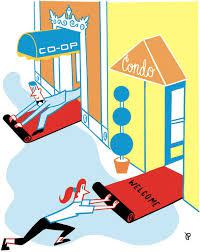 December 2017
December 2017
While it sometimes seems that condo buildings are being built everywhere, Toronto does impose limits on where condo buildings can exist.
The City of Toronto prohibits conversion of apartment buildings to condominiums. This protects affordable and mid-range rental units in the city from being converted to non-rental housing.
Those who choose to purchase a home and desire “condo living” have three options each of which provide specific benefits.
The most popular choice today is to purchase a condo or condominium which means being part -owner of a condo corporation. You own your unit and receive a deed. You share an interest in common elements with all condo corporation members.
Choosing to purchase into a co-op means you own shares in a private company that owns the building and are provided with exclusive rights to occupy a specific unit. One of the advantages of co-op living is that potential owners are pre-screened by the board.
Co-ownership, owning a percentage of the building, is popular in areas where condos are not allowed. Your name goes on title for the building and you receive exclusive rights to a unit in the building. Property taxes are paid as part of monthly maintenance fees. Heat and hydro costs are often included in monthly maintenance fees. Where the city will not allow older apartment buildings to be retrofitted and sold as condos, co-ownership allows these buildings to be repurposed and sold to those who desire condo living. Buyers typically purchase after seeing the retrofitted space rather than relying on building plans which can be changed prior to taking possession.
All forms of “condo living” have a governing body; building management; common expenses and maintenance fees; and the right to sell, lease or mortgage units without consent of other residents or owners.



